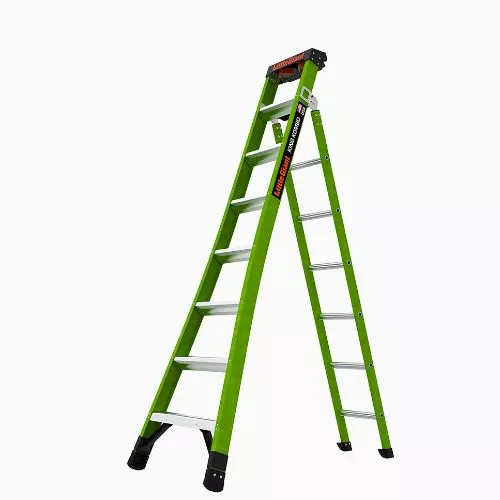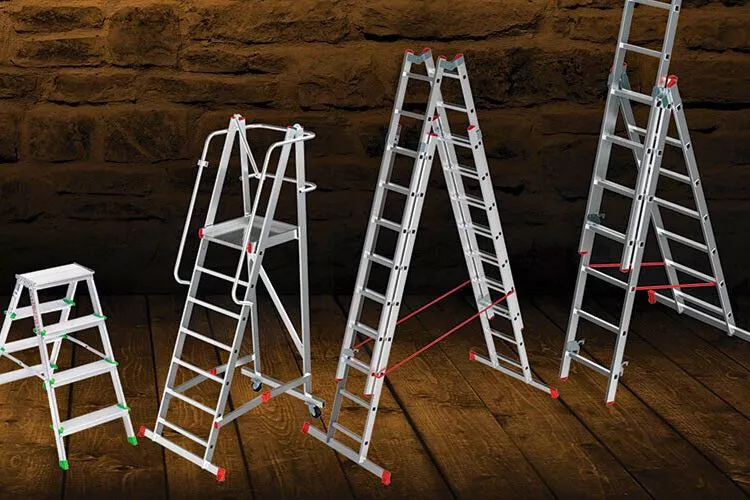The risk of lightning strikes on aluminum ladders is a critical safety concern. Aluminum, a good conductor of electricity, can attract lightning during thunderstorms.
So, can lightning strike an aluminum ladder?
While the probability of a direct lightning strike to an aluminium ladder may be relatively low, the consequences can be severe, including injuries or fatalities.
It is essential to understand the risks involved, follow safety practices, and consider alternative ladder materials when outdoors in stormy weather to prevent accidents and ensure personal safety.

Quick Recommendations
Can lightning strike an aluminum ladder? (The Truth)
Lightning can strike an aluminum ladder if it is in the discharge path. Even though aluminum is a less effective conductor of electricity, it can still conduct electricity and attract lightning.
When lightning strikes an aluminum ladder, it travels through the metal, and the current can pass through a person if they touch the ladder at the time of the strike.
The probability of a direct lightning strike is relatively low, but it is still a risk that should be taken seriously. It is recommended to avoid using metal ladders during stormy weather and to use fiberglass or wooden ladders instead.
If using an aluminum ladder is unavoidable, following safety practices, such as placing the ladder 10 feet away from any nearby buildings or trees and keeping your hands off the conductive rails, is essential.
Alternative Ladder Options for Stormy Weather
🪜Fiberglass Ladders
Fiberglass ladders are a popular alternative to aluminum ones during stormy weather due to their non-conductive properties.
These ladders are made from fiberglass-reinforced plastic, which does not conduct electricity, making them a safer option when working near electrical sources or during thunderstorms.
Fiberglass ladders are also durable, lightweight, and resistant to weather-related wear and tear, making them a reliable choice for various work environments.

🪜Wooden Ladders

Wooden ladders, while not as common as they once were, can still be a viable option during stormy weather.
Wood is a poor conductor of electricity and, as such, reduces the risk of lightning-related accidents.
However, it is essential to ensure the wooden ladder is dry and free from any metal parts that could increase the risk of conducting electricity.
While wooden ladders may not offer the same durability and resistance as fiberglass ladders, they can provide a relatively safe alternative when electrical hazards are a concern.
🪜Insulated Ladders
Insulated ladders are specifically designed for use in environments with electrical hazards, such as stormy weather or proximity to live electrical wires.
These ladders, such as fiberglass, are constructed with non-conductive materials and feature added insulation to further protect the user from electrical shocks.
Insulated ladders often meet specific safety standards, like the ANSI and OSHA requirements, ensuring their suitability for tasks involving electrical hazards.
Although more expensive than standard fiberglass or wooden ladders, insulated ladders provide extra protection when working in stormy conditions or around electrical equipment.

Why don’t electricians use aluminum ladders?
Electricians generally avoid using aluminum ladders because it is a conductive materials that can pose a risk when working around electricity. Contacting an energized power line using a portable metal ladder, including aluminum ladders, can lead to electrocution.

Although aluminum ladders are the least likely to break down over years of use and don’t develop spider-cracks, shatter, or fracture from rough use like fiberglass can, electricians still prefer non-conductive ladders to avoid the risk of electrocution.
Therefore, electricians prefer to use non-conductive ladders, such as fiberglass ladders, for working on electrical systems.
What elements attract lightning?
Lightning is a visible discharge of electricity that occurs when there is an excess electrical charge in a cloud region sufficient to break down the resistance of the air.
Lightning can be attracted to tall and isolated natural objects, such as trees and mountains, which are not necessarily made of metal. The presence of metal does not make a difference in where lightning strikes.
Therefore, it is not the metal itself that attracts lightning, but rather the height, pointy shape, and isolation of an object that are the dominant factors controlling where a lightning bolt will strike.
What metal attracts lightning the most?
No conclusive evidence suggests that any particular metal attracts lightning more than others. Lightning attracts the tallest and most isolated objects, regardless of their composition.

While some metals are better conductors of electricity than others, this does not necessarily mean they will attract lightning more strongly. Silver is the most conductive metal, but the difference between silver and other metals is negligible due to the many variables involved.
Therefore, focusing on lightning safety measures such as avoiding open areas during thunderstorms, seeking shelter in a substantial building or enclosed vehicle, and avoiding contact with conductive surfaces such as metal fences, pipes, and wires is important.
Lightning Safety Tips
In addition to being aware of ladder safety during thunderstorms, it is essential to understand general lightning safety practices when outdoors. Here are some important lightning safety tips to consider:
- Seek Shelter: When thunder is heard, it is a sign that lightning is within striking distance. Seek shelter in a substantial building with wiring and plumbing, rather than an open shelter, picnic pavilion, or other partially enclosed structures.
- Avoid Open Areas: Stay away from open fields, hilltops, and areas with minimal vegetation, as these locations are more likely to attract lightning.
- Unplug Electronics: If indoors during a thunderstorm, unplug appliances and electronic devices to protect them from potential lightning-induced power surges.
- Stay Indoors: Wait at least 30 minutes after the last clap of thunder before leaving shelter. Lightning can strike from as far as 10 miles away, even if the sky appears clear.
- Lightning Position: Avoid lying flat on the ground, as this increases the risk of a side flash, where lightning strikes the ground and jumps to you. Instead, crouch down on the balls of your feet to minimize your contact with the ground while minimizing your height.
- Lightning Detection Apps: Consider using lightning detection apps or checking weather forecasts that provide information on nearby lightning activity to stay informed and prepared.
By following these lightning safety tips and being mindful of ladder safety during thunderstorms, individuals can reduce the risk of lightning-related accidents and ensure their well-being in outdoor environments.
This additional information highlights the significant importance of general lightning safety practices and complements the existing content by providing readers with comprehensive knowledge on outdoor lightning safety.
Conclusion:
In conclusion, while aluminum is a good conductor of electricity, the likelihood of lightning striking an aluminum ladder is dependent on the ladder’s height, location, and surrounding environment.
Though the ladder’s composition may not be the determining factor for a lightning strike, it is crucial to prioritize safety during thunderstorms. Avoid using aluminum ladders outdoors during such weather conditions, and be aware of your surroundings.
Lightning can strike the ground and travel through conductive materials, potentially reaching the ladder.
Adhering to safety guidelines and exercising caution can significantly reduce the risk of lightning-related accidents, ensuring that aluminum ladders remain useful tools in everyday life.





